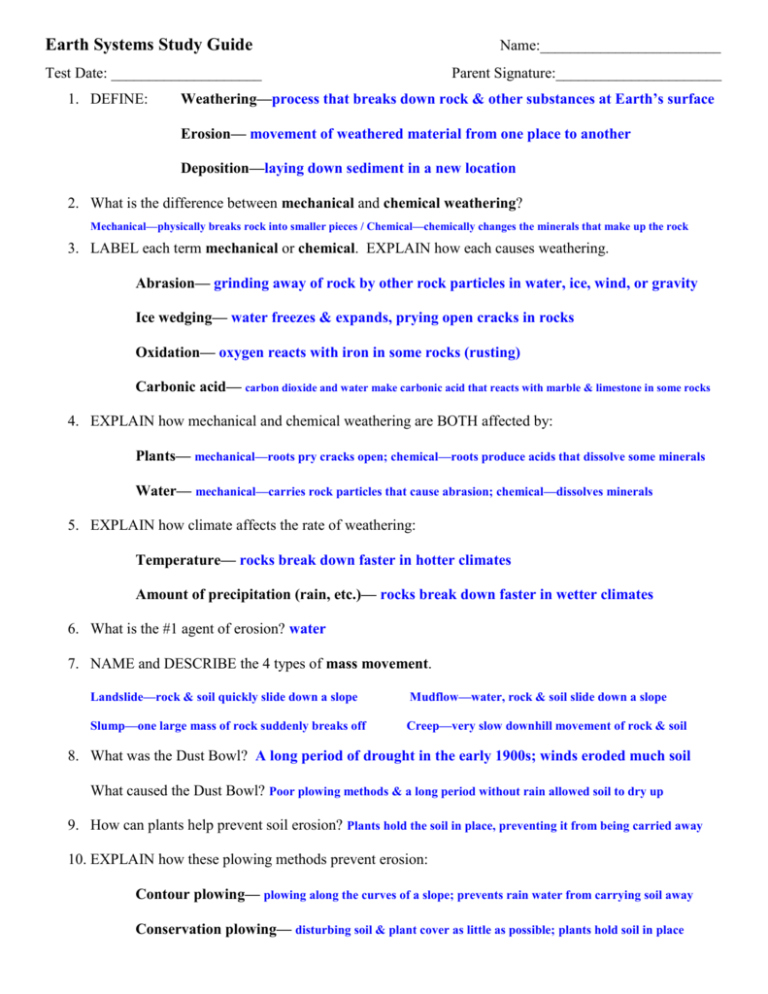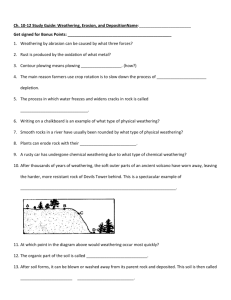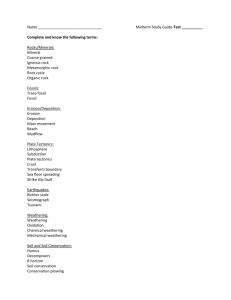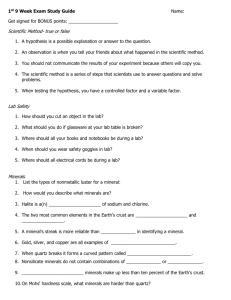Weathering and Erosion Test Study Guide
advertisement

Earth Systems Study Guide Name:________________________ Test Date: ____________________ 1. DEFINE: Parent Signature:______________________ Weathering—process that breaks down rock & other substances at Earth’s surface Erosion— movement of weathered material from one place to another Deposition—laying down sediment in a new location 2. What is the difference between mechanical and chemical weathering? Mechanical—physically breaks rock into smaller pieces / Chemical—chemically changes the minerals that make up the rock 3. LABEL each term mechanical or chemical. EXPLAIN how each causes weathering. Abrasion— grinding away of rock by other rock particles in water, ice, wind, or gravity Ice wedging— water freezes & expands, prying open cracks in rocks Oxidation— oxygen reacts with iron in some rocks (rusting) Carbonic acid— carbon dioxide and water make carbonic acid that reacts with marble & limestone in some rocks 4. EXPLAIN how mechanical and chemical weathering are BOTH affected by: Plants— mechanical—roots pry cracks open; chemical—roots produce acids that dissolve some minerals Water— mechanical—carries rock particles that cause abrasion; chemical—dissolves minerals 5. EXPLAIN how climate affects the rate of weathering: Temperature— rocks break down faster in hotter climates Amount of precipitation (rain, etc.)— rocks break down faster in wetter climates 6. What is the #1 agent of erosion? water 7. NAME and DESCRIBE the 4 types of mass movement. Landslide—rock & soil quickly slide down a slope Mudflow—water, rock & soil slide down a slope Slump—one large mass of rock suddenly breaks off Creep—very slow downhill movement of rock & soil 8. What was the Dust Bowl? A long period of drought in the early 1900s; winds eroded much soil What caused the Dust Bowl? Poor plowing methods & a long period without rain allowed soil to dry up 9. How can plants help prevent soil erosion? Plants hold the soil in place, preventing it from being carried away 10. EXPLAIN how these plowing methods prevent erosion: Contour plowing— plowing along the curves of a slope; prevents rain water from carrying soil away Conservation plowing— disturbing soil & plant cover as little as possible; plants hold soil in place 11. What is soil conservation? Why is it important? Management of soil to prevent its destruction Soil is a natural resource that we depend on, so it needs to be conserved. 12. DEFINE natural hazards. Give 5 examples. (Tornado, tsunami, hurricane, flood, drought, etc.) Event that results from Earth processes & that can cause damage & endanger human life 13. EXPLAIN the effects of catastrophic events that happen: Inside Earth (volcano, earthquake)— change Earth’s crust At Earth’s surface (hurricane, tornado, etc.)— speed up erosion & deposition 14. EXPLAIN how each natural hazard affects weathering, erosion, and deposition: Tornado— debris causes abrasion of structures; tornado picks up items & deposits them in a new location Hurricane— wind & water from the storm cause abrasion and erode sediment Flood— water causes abrasion & erodes land; flood water deposit sediment in a new location Drought— wind can carry soil to a new location 15. LIST 2 human activities that can: Increase the damage of natural hazards— building in floodplains (flood), cutting down forests (landslide) Decrease the damage of natural hazards— boarding up windows (hurricane), conserving water (drought) 16. DEFINE and give EXAMPLES of: Natural resources— any living or non-living thing in the environment that is used by humans Renewable resource— can be naturally replaced in a short amount of time Nonrenewable resource— cannot be replaced as they are used Inexhaustible resource— supply is almost unlimited 17. How can a renewable resource run out? Give an example. Renewable resources can run out if we misuse them. Example: A forest can be wiped out if trees are cut down faster than they are replanted. 18. A community is considering cutting down a small forest to build a new neighborhood. DESCRIBE: 2 costs of cutting down the forest— reduce oxygen produced, soil erosion is more likely 2 benefits of cutting down the forest— new homes for families, jobs for construction workers 19.LIST 5 ways humans can reduce their use of natural resources. Recycle bottles & cans, conserve water (don’t leave the faucet running), set your air conditioner a few degrees higher, buy recycled products, turn out lights when leaving a room, etc.







